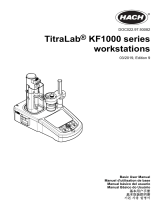Page is loading ...

9
Mi 456 - Mini-titrator
for the determination of TITRATABLE TOTAL ACIDITY for wine analysis
Mi456 is a user-friendly microprocessor-based mini-titrator for the determi-
nation of the titratable total acidity in the process of wine making. This mini-
titrator gives you direct readings in g/L of tartaric acid, with a range of 0.0
to 25.0 g/L.
The instrument comes with a pre-programmed analysis method for the
titratable total acidity measurements on wine sample.
Also called TA and sometimes total acidity, titratable acidity is the sum of the
fixed and volatile acids present in a wine. This is determined by a chemical
process called titration. The titratable acidity is usually expressed in terms of
tartaric acid, even though the other acids are also measured. Titratable acidi-
ty is expressed either as a percentage or as grams per liter. For example, 0.7%
TA is the same as 7 grams per liter (or 7 g/l) TA.
Acidity in the must will result in a poor fermentation and a slightly medicinal
and flat taste. Too much acid will give the wine an unpleasant sourness or
tartness. Some acid is necessary for fermentation, and up to one-fourth of
the initial acid content will be consumed by the yeast during fermentation.
Low-acid musts are usually corrected by adding tartaric acid (the princi-
ple acid in grapes), malic acid, citric acid, or acid blend. An acid testing
kit is indispensable in measuring initial acidity.
Glass electrode & Temp Probe
pH electrodes and Temperature Probe are
supplied with the Mi456.
Accessories
Mi556-001 Calibration standard TA (100 mL bottle)
Mi556-002 Titrant TA (100 mL bottle)
Mi556-003 Buffer pH 7.0 (100 mL bottle)
Mi556-004 Buffer pH 8.2 (100 mL bottle)
MA919B/1 pH Electrode
MA831R Temperature probe
MA9011 Refilling Electolyte Solution 3.5M KCl,
for ORP electrodes, 230 mL bottle
Mi0009 Small stir bars (5 pcs)
Mi0020 50 mL beaker (4 pcs)
Mi0022 2000 µL pipette (1 pc)
Mi0023 Pipette tips for 2000 µL pipette (4 pcs)
www.milwaukeetesters.com
Mi456 Titratable Total Acidity
Range 0.0 to 25.0 g/L of tartaric acid
Resolution 0.1 g/L
Accuracy 5% of reading
Method acid-base titration method
Principle end-point titration
pH calibration 1 point in selected end-point: 7.00 pH or 8.20 pH
Sample Volume 2 mL
Temperature Compensation Automatic from 0.0 to 100.0°C
pH electrode MA919B/1 (included)
Temperature Probe MA831R (included)
Pump Volume 0.5 mL/min
Stirring Speed 1500 rpm
Environment 0 to 50°C; max RH 95%
Power Supply 220V/50 Hz; 10VA
Dimensions 208 x 214 x 163 mm
Weight 2.2 Kg
Ordering Information
Mi456 is supplied complete with:
Calibration standard TA, Titrant TA, Buffer pH 7.0, Buffer pH 8.2,
MA919B/1 pH Electrode, MA831R Temperature probe,
MA9011Refilling Electolyte Solution 3.5M KCl, for pH electrodes
230 mL bottle, small stir bar, 2 x 50 mL beakers, 2000 µL pipette,
test tube set, O-ring, 1 mL syringe, power cable and instruction
manual.
/
